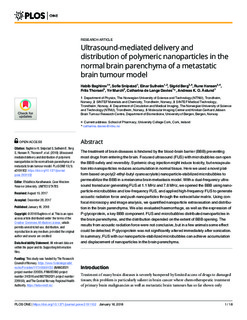| dc.contributor.author | Baghirov, Habib | |
| dc.contributor.author | Snipstad, Sofie | |
| dc.contributor.author | Sulheim, Einar | |
| dc.contributor.author | Berg, Sigrid | |
| dc.contributor.author | Hansen, Rune | |
| dc.contributor.author | Thorsen, Frits | |
| dc.contributor.author | Mørch, Ýrr Asbjørg | |
| dc.contributor.author | Davies, Catharina de Lange | |
| dc.contributor.author | Åslund, Andreas | |
| dc.date.accessioned | 2018-01-23T10:05:12Z | |
| dc.date.available | 2018-01-23T10:05:12Z | |
| dc.date.created | 2018-01-22T10:54:06Z | |
| dc.date.issued | 2018 | |
| dc.identifier.issn | 1932-6203 | |
| dc.identifier.uri | http://hdl.handle.net/11250/2478971 | |
| dc.description.abstract | The treatment of brain diseases is hindered by the blood-brain barrier (BBB) preventing most drugs from entering the brain. Focused ultrasound (FUS) with microbubbles can open the BBB safely and reversibly. Systemic drug injection might induce toxicity, but encapsulation into nanoparticles reduces accumulation in normal tissue. Here we used a novel platform based on poly(2-ethyl-butyl cyanoacrylate) nanoparticle-stabilized microbubbles to permeabilize the BBB in a melanoma brain metastasis model. With a dual-frequency ultrasound transducer generating FUS at 1.1 MHz and 7.8 MHz, we opened the BBB using nanoparticle-microbubbles and low-frequency FUS, and applied high-frequency FUS to generate acoustic radiation force and push nanoparticles through the extracellular matrix. Using confocal microscopy and image analysis, we quantified nanoparticle extravasation and distribution in the brain parenchyma. We also evaluated haemorrhage, as well as the expression of P-glycoprotein, a key BBB component. FUS and microbubbles distributed nanoparticles in the brain parenchyma, and the distribution depended on the extent of BBB opening. The results from acoustic radiation force were not conclusive, but in a few animals some effect could be detected. P-glycoprotein was not significantly altered immediately after sonication. In summary, FUS with our nanoparticle-stabilized microbubbles can achieve accumulation and displacement of nanoparticles in the brain parenchyma. | nb_NO |
| dc.language.iso | eng | nb_NO |
| dc.publisher | Public Library of Science | nb_NO |
| dc.relation.uri | http://journals.plos.org/plosone/article?id=10.1371/journal.pone.0191102 | |
| dc.rights | Navngivelse 4.0 Internasjonal | * |
| dc.rights.uri | http://creativecommons.org/licenses/by/4.0/deed.no | * |
| dc.title | Ultrasound-mediated delivery and distribution of polymeric nanoparticles in the normal brain parenchyma of a metastatic brain tumour model | nb_NO |
| dc.type | Journal article | nb_NO |
| dc.type | Peer reviewed | nb_NO |
| dc.description.version | publishedVersion | nb_NO |
| dc.source.journal | PLoS ONE | nb_NO |
| dc.identifier.doi | 10.1371/journal.pone.0191102 | |
| dc.identifier.cristin | 1548959 | |
| dc.relation.project | Samarbeidsorganet mellom Helse Midt-Norge og NTNU: | nb_NO |
| dc.relation.project | Norges forskningsråd: | nb_NO |
| dc.description.localcode | © 2018 Baghirov et al. This is an open access article distributed under the terms of the Creative Commons Attribution License, which permits unrestricted use, distribution, and reproduction in any medium, provided the original author and source are credited. | nb_NO |
| cristin.unitcode | 194,66,20,0 | |
| cristin.unitcode | 194,65,25,0 | |
| cristin.unitname | Institutt for fysikk | |
| cristin.unitname | Institutt for sirkulasjon og bildediagnostikk | |
| cristin.ispublished | true | |
| cristin.fulltext | original | |
| cristin.qualitycode | 1 | |

